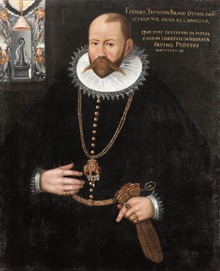
Back Tycho Brahe AF Tycho Brahe AN تيخو براهي Arabic تيخو برايى ARZ Tycho Brahe AST Tixo Brahe AZ Tycho Brahe BAT-SMG Ціха Браге BE Тыха Брагэ BE-X-OLD Тихо Брахе Bulgarian
Tycho Brahe | |
|---|---|
 Portrait, c. 1596 | |
| Born | Tyge Ottesen Brahe 14 December 1546 Knutstorp Castle, Scania, Denmark–Norway |
| Died | 24 October 1601 (aged 54) |
| Alma mater | |
| Occupations |
|
| Known for | |
| Spouse | Kirsten Barbara Jørgensdatter |
| Children | 8 |
| Parents | |
| Signature | |
 | |
Tycho Brahe (/ˈtaɪkoʊ ˈbrɑː(h)i, - ˈbrɑː(hə)/ TY-koh BRAH-(h)ee, - BRAH(-hə), Danish: [ˈtsʰykʰo ˈpʁɑːə] ⓘ; born Tyge Ottesen Brahe, Danish: [ˈtsʰyːjə ˈʌtəsn̩ ˈpʁɑːə];[note 1] 14 December 1546 – 24 October 1601), generally called Tycho for short, was a Danish astronomer of the Renaissance, known for his comprehensive and unprecedentedly accurate astronomical observations. He was known during his lifetime as an astronomer, astrologer, and alchemist. He was the last major astronomer before the invention of the telescope. Tycho Brahe has also been described as the greatest pre-telescopic astronomer.[3][4]
In 1572, Tycho noticed a completely new star that was brighter than any star or planet. Astonished by the existence of a star that ought not to have been there, he devoted himself to the creation of ever more accurate instruments of measurement over the next fifteen years (1576–1591). King Frederick II granted Tycho an estate on the island of Hven and the money to build Uraniborg, the first large observatory in Christian Europe. He later worked underground at Stjerneborg, where he realised that his instruments in Uraniborg were not sufficiently steady. His unprecedented research program both turned astronomy into the first modern science and also helped launch the Scientific Revolution.[5]
An heir to several noble families, Tycho was well educated. He worked to combine what he saw as the geometrical benefits of Copernican heliocentrism with the philosophical benefits of the Ptolemaic system, and devised the Tychonic system, his own version of a model of the Universe, with the Sun orbiting the Earth, and the planets as orbiting the Sun. In De nova stella (1573), he refuted the Aristotelian belief in an unchanging celestial realm. His measurements indicated that "new stars", stellae novae, now called supernovae, moved beyond the Moon, and he was able to show that comets were not atmospheric phenomena, as was previously thought.
In 1597, Tycho was forced by the new king, Christian IV, to leave Denmark. He was invited to Prague, where he became the official imperial astronomer, and built an observatory at Benátky nad Jizerou. Prior to his death in 1601, he was assisted for a year by Johannes Kepler, who went on to use Tycho's data to develop his own three laws of planetary motion.
- ^ Jackson 2001, p. 12.
- ^ Šolcová 2005.
- ^ Grego, Peter; Mannion, David (2010). Galileo and 400 Years of Telescopic Astronomy. New York: Springer. p. 28. ISBN 978-1-4419-5592-0.
- ^ "Tycho Brahe (1546-1601)". www2.hao.ucar.edu. Retrieved 22 July 2024.
- ^ Wootton, David (2015). The Invention of Science: A New History of the Scientific Revolution (1st U.S. ed.). New York: HarperCollins. ISBN 978-0-06-175952-9. OCLC 883146361.
Cite error: There are <ref group=note> tags on this page, but the references will not show without a {{reflist|group=note}} template (see the help page).